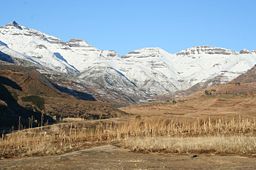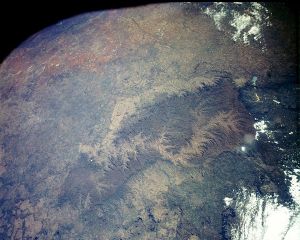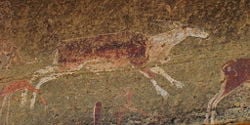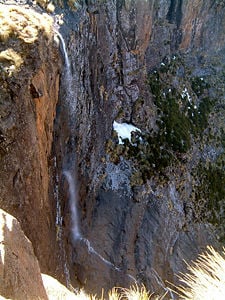Drakensberg
| Drakensberg (Maluti) | |
| uKhahlamba | |
| Mountain Range | |
| Name origin: Dragon's mountain | |
| Countries | South Africa, Lesotho |
|---|---|
| Landmark | Tugela Falls |
| Rivers | Tugela River, Orange River, Vaal River, Caledon River |
| Highest point | Thabana Ntlenyana |
| - elevation | 3,482 meters (11,424 feet) |
| Lowest point | |
| - elevation | 1,294 meters (4,245 feet) |
| Length | 1,000 km (621 miles), SW to NE |
| Geology | Basalt, Sandstone |
| UNESCO World Heritage Site | |
| Name | uKhahlamba / Drakensberg Park |
| Year | 2000 (#24) |
| Number | 985 |
| Region | Africa |
| Criteria | i, iii, vii, x |
| IUCN category | II - National Park |
The Drakensberg (Afrikaans: "Dragon's Mountain") mountains are the highest in Southern Africa, rising at Thabana Ntlenyana to 11,422 feet (3,482 m). In Zulu, they are referred to as uKhahlamba ("barrier of spears"), and in Sesotho as Maluti (also spelled Maloti ). Due to their geological formation they are exceptionally distinctive, and almost unique among mountain ranges. Only the Simien Mountains of Ethiopia resemble the Drakensberg.
The mountains were declared a World Heritage Site in 2000 because their diversity of habitats protects a high level of endemic and globally threatened species, especially birds and plants. This spectacular natural site also contains many caves and shelters with the largest and most concentrated group of rock paintings in Sub-Saharan Africa, made by the Bushmen (or San) people over a period of 4,000 years. The rock paintings are outstanding in quality and diversity of subject and in their depiction of animals and human beings. They represent the spiritual life of the San people.
Geography
The Drakensberg are located in the eastern part of South Africa, running for some 600 miles (1,000 km) generally southwest to northeast, with a northwesterly bend forming the northeastern border of Lesotho with South Africa. They are drained on the west by the Orange and Vaal rivers and on the east and south by a number of smaller rivers, the Tugela being the largest. The range thus separates KwaZulu-Natal Province from Free State Province, looming over the nearby coast of Natal.
The highest peak is Thabana Ntlenyana (11,424 feet or 3,482 m), also the highest peak of Lesotho. Other notable peaks include Mafadi at 3,450 m, Makoaneng at 3,416 m, Njesuthi at 3,408 m, Champagne Castle at 3,377 m, Giant's Castle at 3,315 m, and Ben Macdhui at 3,001 m. All of these are in the area bordering on Lesotho; north of Lesotho the range gradually becomes lower and less rugged until entering Mpumalanga, where the quartzite mountains of the Transvaal Drakensberg are more broken. The Blyde River Canyon in Mpumalanga is technically within the northern reaches of the Drakensberg, though its geology appears quite different due to the lack of a basalt cap.
The Royal Natal National Park is located in the KwaZulu Natal province of South Africa and forms part of the uKhahlamba Drakensberg Park, a World Heritage Site.[1] Notwithstanding the name, it is actually not a South African National Park managed by the SANParks, but rather a Provincial Park managed by Ezemvelo KZN Wildlife. Tugela Falls is located within the park.[2]
Geology
Geologically, the Drakensberg is a remnant of the original African plateau. The mountains are capped by a layer of basalt up to 1,500 m thick, with sandstone lower down, resulting in a combination of steep-sided blocks and pinnacles. The sandstone layer was deposited as the remnants of a gigantic lake that occupied much of what is now Southern Africa ca 500 million years ago, whereas the basaltic layer was deposited ca 220 million years ago in what many geologists think was the largest volcanic eruption in the history of the world (linked with the splitting of the tectonic plates of Africa and South America).
Subsequently, water and wind erosion (principally from the east, facing the Indian Ocean) cut into the enormous plateau, producing an extraordinary and almost unique landcape. The Drakensberg is one of only two mountain ranges (along with the Simien Mountains of Ethiopia) to have been formed in this geological way, which accounts for its extraordinarily distinctive formations and colors. The landscape is dominated by extremely steep cliffs, some of them regarded as being among the most impressive cliff faces on earth, incised buttresses, and soaring ramparts.
Climate
Snow falls regularly in the winter, while rain and mist can occur year-round. In summer the valleys of the mountains often see temperatures in the 90 to 100 degrees Fahrenheit range (mid to high 30 degrees Celsius), while in winter temperatures on top of the mountains may plunge to -4 degrees Fahrenheit (below -20 Celsius). Snow is known even in summer, and Cathedral Peak Hotel, one of the most popular resorts in the Drakensberg, has known a white Christmas.
Flora and fauna
Because of the different climate zones, great differences in altitude and a copious supply of water, one finds in the Royal Natal National Park an extreme diversity of plants. So far, more than 2,000 species were registered, most of them blossom-bearing. There are 72 species of ferns alone, among them the huge fern trees typical of the Drakensberg.
Drakensberg is considered a montane grasslands and shrublands biome as defined by the World Wildlife Fund. Such areas, particularly in subtropical and tropical regions, often evolved as virtual islands, separated from other montane regions by warmer, lower-elevation regions. Among the mammals to be found are the mountain reedbuck, an antelope that eats grasses and leaves, and the grey rhebuck, an antelope that browses on shrubs and forbs. There are 290 species of birds and 48 species of mammals to be found in the park.[3]
History
Caves are frequent in the more easily eroded sandstone, and many have rock paintings by the Bushmen (San). The Drakensberg contains thousands of works of Bushman art and is the largest collection of such work in the world. Due to the materials used in their production, these paintings are difficult to date, but there is anthropological evidence, including many hunting implements, that their civilization existed in the Drakensberg at least 40,000 years ago and possibly over 100,000 years ago.
The Bushman population was decimated in various wars from the seventeenth century, mostly between them and other African tribes invading the fertile area. Ultimately they were completely annihilated by Europeans in the nineteenth century, due principally to confusions over claims to land and hunting animals. Being hunter-gatherers, the Bushman did not believe in ownership of livestock but did believe strongly in hunting grounds (the opposite of the view held by Europeans). Thus the Bushman would hunt European livestock, and the Europeans would infringe on hunting grounds, neither with a concept that they were transgressing a rule of the other. Both sides responded, with Bushmen raiding the Europeans and Europeans attacking the Bushmen. The superior technology of the European guns and weapons spelled certain disaster for the Bushman, and the last one was seen in the late nineteenth century. There are still Bushmen tribes dwelling in the Kalahari and Namib deserts, but the culture of mountain Bushmen no longer exists.
Activities
In the southern Drakensberg there is a ski resort called Tiffindell that is open from late May to early September. Tiffindell may receive as much as 2.5 meters of snow during good skiing years.
Many of the Drakensberg peaks offer challenging mountaineering. While the major summits have all been conquered, a number of minor pinnacles have yet to be ascended. Hiking is a popular activity, as are fishing, swimming, whitewater rafting, horseback riding, and birdwatching.
Tourism in the Drakensberg is developing, with a variety of hotels and resorts appearing on the slopes. Most of the higher South African parts of the range have been designated as game reserves or wilderness areas. The uKhahlamba or Drakensberg National Park, located in KwaZulu-Natal, near the border with Lesotho, was listed by UNESCO in 2000 as a World Heritage Site. The park is also on the List of Wetlands of International Importance. But it is the central Drakensberg that offers tourists the best access to Bushman rock art and the largest range of hiking trails.
The best-known national park in the Drakensberg is Royal Natal National Park, where the Amphitheater can be seen, a rock wall approximately 5 kilometers long and 500 meters high. It contains the source of the Tugela River and includes Tugela Falls, the second highest waterfall on earth.[4] The total drop in five free-leaping falls is 3,110 feet (947 m). The source of the Tugela River (Zulu for "sudden") is at Mont-Aux-Sources, several kilometers from the escarpment from which the falls drop. Mont-aux-Sources is also where, as its name implies, the Orange River begins its journey to the Atlantic Ocean.
Notes
- ↑ Department of Environmental Affairs and Tourism. uKhahlamba Drakensberg Park Retrieved February 21, 2009.
- ↑ Ezemvelo KZN Wildlife. uKHAHLAMBA DRAKENSBERG PARK - ROYAL NATAL Retrieved February 21, 2009.
- ↑ Drakensberg Tourism. Drakensberg Retrieved February 20, 2009.
- ↑ World Waterfall Database. Tugela Falls Retrieved February 21, 2009.
ReferencesISBN links support NWE through referral fees
External links
All links retrieved February 20, 2009.
- Drakensberg Tourism Association
- Royal Natal at KZN Wildlife
- uKhahlamba Drakensberg Park at UNESCO World heritage
- Royal Natal National Park
- South Africa Nature Reserves
- SouthAfrica-travel.net
Credits
New World Encyclopedia writers and editors rewrote and completed the Wikipedia article in accordance with New World Encyclopedia standards. This article abides by terms of the Creative Commons CC-by-sa 3.0 License (CC-by-sa), which may be used and disseminated with proper attribution. Credit is due under the terms of this license that can reference both the New World Encyclopedia contributors and the selfless volunteer contributors of the Wikimedia Foundation. To cite this article click here for a list of acceptable citing formats.The history of earlier contributions by wikipedians is accessible to researchers here:
The history of this article since it was imported to New World Encyclopedia:
Note: Some restrictions may apply to use of individual images which are separately licensed.




